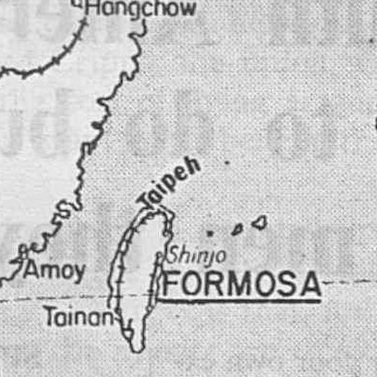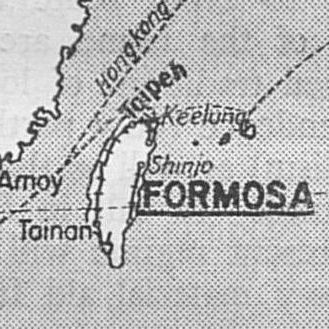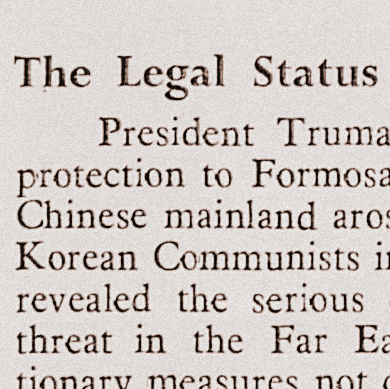下面是1913年7月26日發表在《經濟學人》(The Economist)的一篇文章,內容主要是簡短報導台灣當時的狀況。點開以下摺疊標簽,可以閱讀中文翻譯與原文,這些資料的二手來源是「HUSO」資料庫。
福爾摩沙
(作者來稿)
為了收集植物,我在1912年的大半時間裡,都待在一座人們所知甚少,但既優美又饒富趣味的日本殖民地——福爾摩沙。以下簡短描述該島的現況,希望《經濟學人》的讀者們能對此感到興趣。作者主要是前往開發較少、由土著部族所居住的山區。這些部族的發展程度在個別面向上或有高低,不過這已經超出文章範圍。
在1894年日中戰爭之前,福爾摩沙是中國的行省之一。無論北京官方如何看待,福爾摩沙的價值早已被中國南方的福建人與客家人所認識,這點可以從當地龐大的中國人口得知。在中國本土並沒有一個地方能像該島西部平原一樣密集耕作,如果颱風沒毀掉其中一次,那麼稻米一年可以有三次收成,此外這裡還有生長可達到80英呎之高的竹叢。1895年時,日本人在北部的基隆登陸,雖然該島已經在戰爭結束後正式被中國交出,但日本人在福爾摩沙所要遇上的麻煩此時才正要開始。「無止息的一場戰爭」從那時延續到現在,初期所面對的是中國人的反抗,接著對上的則是武裝獵頭者。期望有一天日本能夠從金錢與生命的犧牲之中取得回報。由於遭遇了巨大障礙,無論人們是喜歡或是討厭,都無須訝異於目前政府在管控與專賣措施上所實行的極端政策。
正如預料,福爾摩沙政府是個獨裁體制,軍事首長支配山區,民政首長則主管平原,兩者名義上對總督負責。所有的立法權都掌握在「福爾摩沙評議會」(Council of Formosa)的手上,這是一個由總督自行指任的官方機構,其成員代表各政府部門的首腦,似乎擁有近於完全的自由權限。
警察在管理方面獲得全面授權,與民政部門可說合作地相當成功。平原地帶被分割成數個「廳」(cho),分別由其首長主持,並且配有高效而無所不在的警力,其職責似乎僅止於體力勞動。福爾摩沙在管理方面或許比在政策方面還值得敬佩。也許是複製了某些德國教科書,這裡呈現一種對於細節的詳盡與專注,即使只是短暫到訪的人也能對此留下深刻印象。無論是首府台北或是任何一個地方城市,只要進到政府辦公廳,就可以看到一種發揮到極致的「文書主義」(red tapeism),有鑒於所有的政令與公文都需要經過一再簽批,可說根本不可能發生失誤。福爾摩沙在管理上值得一提的另一項特色,是政府各部門的極度專業化。每位官員都擁有且認識到自己所屬的位置。所有的能量都投入在自己的研究或工作領域,直到快變成一部無力再提供什麼應用的百科機器為止。由此,需要有聰明的各部門首長來整合下級知識,並在深具影響的國家特殊條件之下將其運用,從而在未來避免出現諸如缺乏牧地卻設有實驗牛羊牧場;乾季明顯卻設有橡膠與柚木實驗園之類的事;又或者避免在一個人們並不關心相關事務的地方設立動物園等。
福爾摩沙政府在某些方面有些過度熱忱,但16年來確實在管理上展現出無可爭議的記錄。從1896年到1911年間,收入從零增加到4300萬圓;對中央政府補貼的接收,也從1896年的1000萬圓減少到1905年的零圓。
從政府的資產負債表,可以看到近年來還不錯的年度結餘。不過,從此處無法看到針對土著的軍事行動支出,這部分開銷對福爾摩沙或統治國而言都是一種負擔。
針對土地制度,福爾摩沙正在推行一項措施,而日本佔領前的狀況是其中利害所在;由於在民族上算是中國,這顯然是西方的土地權屬形式在中國成功應用的唯一實例。在中國的統治下,由於許多「道台」(tao-tai)的無能,又或者出於賄賂,農耕用的土地多半被一種稱做「墾首」(Kansheu)的人所強佔,或許可以將此稱號翻譯成封建領主,他們已成為許多上十萬英畝土地的完全所有者,並根據道台的權力支付地租。租戶被迫定期參與針對蕃人的征服性軍事行動。到了後期,大地主逐漸沒落,其權力也隨著租戶的成長而衰減。在中國人用之不竭的勤奮節儉下,農民能夠在很大程度上將自己從地主手中解放出來,但即便如此,也只是轉為腐敗政府的奴隸罷了。地租通常採取什一制,也就是收成的十分之一。很少有屬於自由保有的土地,曾經有些來自廣東、漳州與泉州的殖民者做過一次有趣的嘗試,他們稱福爾摩沙東北部的宜蘭為「三個家族所共有的土地」,並企圖在此展開不受政府干預的耕作,當然最後還是失敗。
日本人到來之初所要處理的大事之一,便是一項完整的土地調查,以評估土地稅賦。其次,藉由政府的特別補貼,所有「大租」(Taiso;地主)的權利,都以四百萬圓的價值被強制買下,並允許先前的租戶透過納稅將土地佔有。這項稅收在1911年達到約三百萬圓,雖然只佔整體收入的一小部分,在日本人眼裡卻是相當神聖,被稱作是「政治上最為重要」之事。由於這項理由,該稅受到盡可能的延續,當有需要調節收入時,處理方式是巧妙變動樟腦、鹽與阿片三項政府專賣品的價格。依照近期稅率表,稻田與高地被分成十個等級,按此分級,前者的稅金在每「甲」(2.4英畝)1.50圓到17.80圓之間。這樣的稅率以中國人的觀點來說無疑是相當地高,也連帶地使工資高於中國本土,達到平均每日約.70圓,進而更多苦力勞工的引進已經上路。另一方面,福爾摩沙的苦力勞工比日本人更加便宜,如果沒有這項因素,即便日本人有著各種先進知識,也難以達成他們在管理與蕃族戰事上的各種事務。一位中國人會很清楚知道自己較高的工資已經超過物價與稅收支出,至於屬於西方文明的衛生與供水設施,以及不計其數的規矩,對他則缺乏吸引。他不是那種期待著「生意上創造高利潤的機會能有所增進」的人,即便他確實知道此種機會已為誰所創造。到目前為止,國有政策限縮在三項專賣品,以及森林和鐵道,不過可以預期未來大面積的糖、稻米與茶業土地,也將會被收歸政府經營。
至此可見日本人在重整土地稅賦時所必須面對的難處。福爾摩沙的「墾首」與日本人的到來,已被拿來和日本舊時的大名與1868年的維新互作比較。另一個不那麼合適的比較對象,則是滿洲政府與去年的革命。新的北京政府將對中國所做的,或許會比套用日本在福爾摩沙(曾經屬於中國)所施行的土地稅措施還差。
貿易數字顯示福爾摩沙在1902年的出口總額達到21,224,366圓,進口總額則有19,335,822圓。以大約三百萬的人口來推算,平均的人均出口額在7.07圓,進口額則為6.44圓。主要的出口品是烏龍茶,出口額占總體的百分之41;稻米占百分之20;樟腦占百分之17。若計算對日本的總出口額,則稻米占了其中百分之35;紅糖占百分之34,樟腦油占百分之12。
烏龍茶貿易,即島上最重要的貿易,目前完全掌控在英國人、美國人與中國人所經營的商行手上,但有跡象顯示政府也企圖介入分食。歷史不甚清晰的烏龍茶帶有別於其他茶類的獨特風味,其原因出自特殊的生產流程,其中茶葉經過一道額外的「做青處理」(bruising process)。1902年所出口的茶葉量達到13,843,125磅,價額則達到六百萬圓(占出口總額的三分之一),以重量計,其中百分之83銷往美國,百分之12銷往日本,百分之3則往英國。砂糖貿易無疑是福爾摩沙的未來,不過相對茶業來說是個年輕的產業。政府對糖業農園與工廠的建立多所刺激,針對面積高於12½英畝的土地,必要時政府將會支付以每¼英畝2圓,同時也補貼那些每日可處理達75,000磅甘蔗的機械化糖廠。其中規模最大者是位於橋仔頭的臺灣製糖株式會社,屬於部分官營,據稱可以在24小時內處理達300噸的甘蔗。
目前產量最多的是紅糖,在琉球群島也有生產,這種糖現有的銷路僅止於日本。至於白糖出口目前還很少,原因在於缺乏有效率的工廠,在1904年時,銷往國外的白糖價額只達166,751圓,銷往日本者則有352,823圓。要從中國人手上取得充足的栽種土地相當困難,他們不滿自己的稻田受到干涉,這也是一個例子,反映著在中國人身上施加西洋方法的困難性。
在樟腦、鹽與阿片這三種政府專賣品中,值得一提的只有最前者。
樟樹分布於北部與中部的特定山區,其茂盛程度或有變異,在日本佔領之前,由於中國人長期且浪費的榨取,已經多所枯竭。目前只有在北部的內山還可以找到大量的樟樹供給,而且還有待與蕃人的戰事結束,才有辦法平和地佔領採收。若能如此,那麼無疑地產出將可以加倍。至於供給的持續性,問題則在於日本人所施行的大量樟樹植栽足夠支應之前,野生樟樹是否會先耗盡。
這裡不打算描述樟腦的製造過程,不過或可一提廉價的中國勞工,多半出於其貢獻,無論從採收到粗製樟腦,再到臺北蒸餾廠的樟腦油,生產開銷都能降到最低。樟腦從業者皆為雇用苦力勞工的日本人,他們依照森林面積向政府支付租金,並以固定價格向政府銷售。在1910年,總計政府已經藉販售樟腦賺取達5,529,558圓,其中淨收益達到約三百萬圓,重量則達到有四百萬磅。
價格是由總督所訂定,結晶樟腦分為三種等級,分別為每擔(133磅)30、27與24圓,樟腦油則為每擔15圓。
專賣局也會訂定每年樟腦與樟腦油的最大需要量,以及鍋爐設置和樹木採伐的最大數量。
R. P.Formosa
(From a correspondent)
After spending the greater part of the year 1912 in a little-known, but exceedingly interesting and beautiful colony of Japan—namely, Formosa—for the purpose of plant collecting, I venture to hope that the following short account of the conditions existing at present in that island may be of interest to some readers of the Economist. The writer travelled chiefly in the more undeveloped, mountainous districts of the interior, inhabited by aboriginal tribes. Their state of development, low in some respects and high in others, is, however, beyond the scope of this article.
Before the Japanese-Chinese war of 1894 Formosa formed a Province of the Chinese Empire. That its value was fully recognised in former times by the Fokien and Hakka populations of South China, if not by the authorities at Peking, is indicated by its large existing Chinese population. Nowhere on the mainland can such intense cultivation be seen as on the western plains of this island, where three crops of rice can be taken in the year, if the typhoons do not spoil one, and the bamboo groves tower to the height of 80 feet. The Japanese landed at Keelung in the North in the year 1895, but though the island had been officially handed over to them by China at the termination of the war, they found that their troubles, as far as Formosa was concerned, had only begun. “A continual war” has from that time to this been in progress, first against rebellious Chinese, then against armed headhunters. Some day, it is to be hoped, Japan will reap the benefit of her sacrifices of money and lives. Her difficulties are great, and though one may be amused (or annoyed), one cannot be surprised, considering the conditions, at an extreme policy of Government control and monopoly.
The Government of Formosa is, as one would expect, an autocracy, the military Governor being supreme in the mountains, the civil Governor on the plains, both nominally responsible to the Governor-General. All legislative power are in the hands of the “Council of Formosa,” an official body elected by the Governor-General himself, it members representing the heads of the various Government departments, and possessing a freedom of action which one suspects to be bordering on the absolute.
As regards administration, this duty has been delegated entirely to the police, the civil and police departments apparently co-operating with success. The plains are divided into “cho,” or prefectures, presided over by their respective governors, and staffed with a very efficient and ubiquitous police, whose duties appear only to stop short at manual labour. Formosan administration is perhaps more to be admired than Formosan policy. Copied probably from German text-books, it shows a thoroughness and attention to detail which must impress even the casual travelers. The impression one obtains on entering a Government office either at Taihoku, the capital, or at any of the provincial towns, is that “red tapeism” has here reached its fullest possible development, and that, considering the number of times all order papers and official documents require signing and counter-signing, mistakes must be for ever impossible. Another noteworthy characteristic of Formosan administration is the extreme specialization in all branches of government. Every man (man is synonymous with official) has his places, and knows it. His whole energy is devoted to his own sphere of study or work till his in danger of becoming a mere mechanical encyclopedia without power of application. There seems to be a real need for intelligent heads of bureaus, capable of correlating the knowledge of their subordinates, and applying the same to the decidedly peculiar conditions of the county, so as to prevent in future the establishment of such institutions as an experimental sheep and dairy farm in a country devoid of pasture; experimental hevea and teak plantations in a country with a pronounced dry season; and zoological gardens in a country where people do not care such things.
Though over-zealous in some respects, the Formosa Government exhibits a by no means discreditable record of 16 years’ administration. The years 1896-1911 show an increase of income from nil to 43 million yen, and a decrease of subsidy from the Central Government from 10 million yen in 1896 to nil in 1905.
The Government balance-sheet appears to show a fair annual surplus for the last few years, but how far the expenses of military operations against the aborigines are regarded as liabilities of Formosa or of the ruling country, is uncertain.
A short account of the land system at present in force in Formosa, and of the conditions prior to the Japanese occupation, is of a certain interest; for it is the only example of an apparently successful application of a Western form of land tenure to China; for Formosa is ethnographically China. During the Chinese régime, owing to the inability or venality of the various “Tao-tais,” or governors, a large proportion of the agricultural land was usurped by individuals known as “Kansheu,” possibly to be translated as feudal lords, who became absolute owners of several hundred thousand acres apiece, for which they paid rent according to the “Tao-tais’” power to demand it. Periodically the tenants were forced into military campaigns against the savages with a view to conquest. In later years these great landlords became effete and their power waned in proportion as that of their tenants grew. The inexhaustible thrift and diligence of the Chinese enabled the peasant to free himself in large measure from his overlords, but only to become the slave of a corrupt Government. Rents were usually on the tithe system, a tenth of the crop. Freehold land was a minimum, but an interesting attempt was once made by some colonists from Canton, Chang-chow, and Chuan-chow to cultivate free from Government interference the fertile plain of Giran in N.E Formosa, which they named the “land common to the three families.” The attempt, of course, failed.
With the advent of the Japanese, one of the first large work to be undertaken was a complete land survey for the purpose of assessment for land tax. Secondly, by special Government grant, all “Taiso” (landowners) rights were compulsorily bought to the value of four million yen, and the former tenants allowed to occupy in payment of a land tax. This tax, which in the year 1911 amounted to about three million yen, is but a small contribution to the general revenue, but is, nevertheless, sacred in Japanese eyes, and las been described as “most important politically.” For this reason it is kept as constant as possible, and when the revenue needs regulating this is done by the ingenious method of varying the prices of the three Government monopolies—camphor, salt and opium. The paddy (rice) fields and the uplands are divided into ten classes by the latest land tax schedule, the former paying from 1.50 yen to 17.80 yen per “ko” (= 2.4 acres), according to the class. These taxes are undoubtedly high from the Chinese point of view, with the result that wages are now considerably higher than on the mainland of China, averaging about .70 yen per day, and a movement is already on foot for the importation of more coolie labour. On the other hand, Formosan coolie labour is cheap compared with Japanese, and without this it is inconceivable that the Japanese, in spite of all their advanced knowledge, could have accomplished what they have done, both in administration and savage warfare. The Chinaman is well aware that his higher wages are more than balanced by increased prices and taxation, and the amenities of Western civilisation in the form of sanitation, water supply, and innumerable regulations are unattractive to him. He is not the sort of man who looks forward to “the increased opportunities for making large profits in business,” as he recognises for whom these opportunities were made. Up to now the policy of State ownership has confined itself to the three monopolies, forests, and railways, but it is expected that in future large areas of sugar, rice, and tea land will be taken up and worked by Government.
The above may give some idea of the difficulties which the Japanese have had to contend with in the reorganisation of the land tax. The “Kansheu” of Formosa have been compared with the old Daimyos of Japan, and the advent of the Japanese with the restoration of 1868. Another less plausible parallel is with the Manchu Government and the Revolution of last year. In any case, the new Peking Government might do worse than apply to China most, at any rate, of the provisions of the land tax which the Japanese have applied to what once was China.
Trade figures show for the year 1902 total exports to the value of 21,224,366 yen, and imports 19,335,822 yen. Reckoning the population at about three millions, the value of the exports will average 7.07 yen per head, and the imports 6.44 yen. The chief exports abroad are Oolong tea, representing 41 per cent. of the total value; rice 20 per cent.; and camphor 17 per cent. Of exports to Japan only, rice represents 35 per cent. of the value, brown sugar 34 per cent., and camphor oil 12 per cent.
The Oolong tea trade, the most important trade in the island, has up to now been entirely in the hands of English, American, and Chinese firms, but of late there have been signs that the Government intend to take some of it into their own hands. The history of this tea is obscure, but its peculiar flavour, unlike that of any other tea, is undoubtedly due to a different process of manufacture, in which the leaf is subjected to an extra “bruising process.” Of the total weight of 13,843,125 lbs of tea exported in the year 1902 to the value of six million yen (about one-third of the value of the total exports), 83 per cent. weight was sold to America, 12 per cent. to Japan, and 3 per cent. to England. The sugar trade has undoubtedly a future in Formosa, but, unlike the tea, is a comparatively young industry. The Government is doing much to stimulate the establishment of sugar estates and plant, paying expenses when necessary on areas above 12½ acres up to 2 yen per ¼ acre, and subsidising manufacturers using machinery capable of turning out over 75,000 lbs of cane per day. The largest undertaking, the Formosa Sugar Company, at Kyoshito, is partly a Government affair, and is said to turn out 300 tons of cane in 24 hours.
By far the largest proportion of sugar is brown sugar, which, with that from the Loochoo Islands, finds a ready market in Japan alone. Export of white sugar has till lately been small, owing to lack of sufficient plant, in 1904 only 166,751 yen value being sold abroad, and 352,823 yen in Japan. Considerable difficulty is being experienced in obtaining sufficient land for planting from the Chinese, who resent the interference with their rice fields, this affording another example of the difficulties in the way of establishing Western methods on the Chinese.
Of the three Government monopolies, camphor, salt and opium, the first only is worth considering.
The camphor trees, which grow more or less thickly, distributed over a certain zone of the northern and central mountains, had up to the year of Japanese occupation suffered a considerable diminution owing to their long and wasteful exploitation by the Chinese. At the present time the only large supply of these trees is to be found in the more central parts of the northern mountains, and it will be some years before the present state of savage warfare gives way to peaceful occupation by camphor collectors. When this time comes there is no reason why the output should not be doubled. As regards maintenance of supply, it is only a question whether or not the present supply of wild camphor will be worked out before the large camphor plantations already made by the Japanese come into bearing.
Though it is not intended here to enter into a description of the processes of camphor manufacture, it may be stated that, thanks in great part to cheap Chinese labour, the expense of manufacture, at any rate from the time of cutting to the arrival of the crude camphor and oil at the Taihoku distillery, is at a minimum. The camphor workers themselves are invariably Japanese, employing coolie labour, who pay rent to the Government for their respective areas of forest, and sell to the Government at a fixed price. In the year 1910 the sum of 5,529,558 yen accrued to the Government from the sale of camphor, the net profit being about three million yen on about four million lbs sold.
Prices are fixed by the Governor-General, crystal camphor being bought in three grades for 30, 27, and 24 yen respectively per picul (133 lbs), and oil for 15 yen.
The Monopoly Bureau also stipulates annually the maximum amount of camphor and oil required, and the maximum number of stoves to be set up and trees to be felled by the workers.
R. P.或許是按照《經濟學人》的習慣,這篇文章沒有明確的署名。不過作者提及自己1912年時正在台灣收集植物,且文章最末也給了縮寫「R. P.」,由此來看或許是一位叫做William Robert Price的植物學家,他在1912年時與蝶類學家Henry Elwes到台灣收集樣本。關於這個疑似作者的人物,英國「Kew皇家植物園」網站上有篇blog,提及Prince在台灣的期間收集了有1133份標本,並提供給日本植物學家早田文藏。
嘗試在台灣本地的文獻尋找關於Price的記錄時,發現1926年10月1日出刊的一期《台灣博物學會會報》上有篇小短訊,題為〈プライス君の消息〉,作者是植物學家金平亮三,其中說到Price後來曾在一次大戰時加入軍隊,以及收藏許多台灣資料與物品等等。
針對某些翻譯上並不是非常肯定的名詞,以下稍加解說,首先,文中「Council of Formosa」所指的可能是由總督所指定出任的「台灣總督府評議會」;其次,描述土地狀況時所提到的「道台」、「墾首」與「大租」三個名詞,分別是根據英文音譯「Tao-tai」、「Kansheu」與「Taiso」所推測的漢字對應,後兩者比較像是日語發音。
至於在數據方面,關於作者提到的1911年政府收入與地租稅收,這裡參考1914年《臺灣金融事項參考書》做了一個簡單圖表,從中可見總體收支與地租收入從明治31年到到大正元年之間的變化:
另外,文章中稱「1902年所出口的茶葉量達到13,843,125磅」,數字和參考書上所記的當年烏龍茶出口量相同,不過實際上單位應該是「斤」,而不是作者所直接套用的英制單位。
最後,附上一張年度進出口貿易總額變化圖:
「移出(入)」代表的是對內地(日本本土)的貿易,「輸出(入)」則是對外國的貿易,這是上述參考書本身所使用的區隔寫法,將兩者相加才是台灣對外貿易總額。
- Harrington, K. (2011) Early 20th century plant hunting in Taiwan. Kew Library Art and Archives blog.
- 金平亮三 (1926) プライス君の消息. 臺灣博物學會會報.
- 臺灣銀行 (1905) 第四次臺灣金融事項參考書.
- 臺灣銀行 (1914) 第九次臺灣金融事項參考書.



